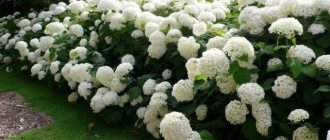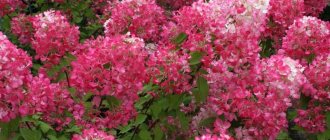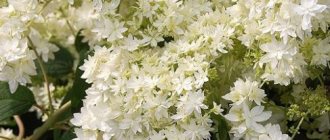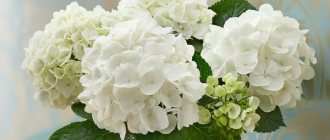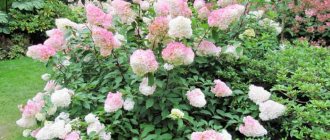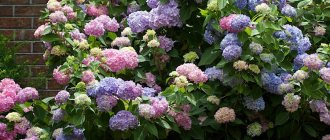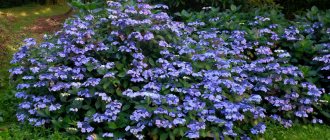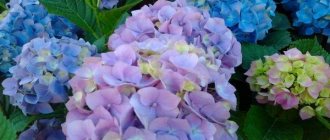This variety of serrate hydrangea is a little different from all the others: the huge blue inflorescences are very beautiful. Like many other varieties, bluebird hydrangea changes color and color intensity as the flowering period continues. The saturation of the color shade depends on the acidity of the soil.
Any hydrangea, including this variety, likes to grow on fertile soil, prefers moist soil and morning sun. It does not grow under trees and is completely in the shade. These small bushes are frost-resistant and bloom from June to September. The inflorescence consists of two types of flowers.
Description of hydrangea serrata Bluebird
Serrata hydrangea (hydrangea serrata bluebird) is a shrub with a strong trunk. For a long time it was considered a greenhouse dweller, but today it is planted everywhere.
The height of the plant reaches 120 cm. The leaves are bright green, oval-shaped, up to 12 cm long. The crown width often exceeds 1.5 m.
Hydrangea serrata Bluebird has large inflorescences with a diameter of up to 8 cm. They are able to change color depending on the composition of the soil. In the center of the inflorescence there are small white-blue or light pink flowers. Along the edges of the “panicle” there are large flowers, which, after blooming, acquire a milky pink and bluish tint.
Types and varieties
The most popular varieties of serrated hydrangea among domestic gardeners include:
- Bluebird;
- Koreana;
- Preciosa.
Bluebird
Hydrangea Bluebird was created by Japanese breeders. The name of the variety is translated into Russian as “blue bird”. It belongs to the type of hydrangea milcoserrate. The plant is a branched shrub that grows up to 120 cm in height and up to one and a half meters in width.
If you read the description of the Blue Bird hydrangea flower, it will be impossible to confuse it with another variety. The shrub has oval leaves with small teeth of bright green color, petals of blue, deep blue or even purple shades.
Bluebird
Hydrangea serrata Bluebird is characterized by shallow roots. The variety is quite winter-hardy, but it is not suitable for growing in Siberia. Bluebird hydrangeas can withstand cold temperatures of at least -20 degrees.
The flowering period of Bluebird serrata hydrangea is quite long. It lasts from July to September inclusive.
In the case of Bluebird hydrangea, planting and care are carried out similarly to other varieties of shrubs. More detailed information on growing Blue Bird hydrangea with detailed descriptions can be found on numerous websites on the Internet.
Koreana
Hydrangea Koreana is one of the varieties of garden serrated hydrangeas. This is not a very tall spreading shrub, the main feature of which is the presence of beautiful variegated inflorescences in the form of a shield-shaped panicle, about 8 cm in diameter.
Hydrangea Koreana
The central fertile flowers are usually variegated white-pink or white-blue, the outer ones (without reproductive organs) are four-leafed, single-colored blue or pink.
The trunk of the shrub is branched, very strong and covered with bark, and is practically invisible behind the numerous lush inflorescences and rich foliage.
Koreana's winter hardiness is average. To grow in regions with a relatively harsh climate, the plant should be carefully insulated during cold weather. In snowy regions, it is strongly recommended to cover the plant with snow on top of the insulation.
Preciosa
Hydrangea Preciosa is a fairly compact shrub that grows up to 1.5 meters. This variety is characterized by very original colors of inflorescences.
Hydrangea Preciosa
Sterile flowers begin to bloom yellowish-green, then turn pink and blue, becoming purple and burgundy closer to autumn. The foliage, which is bright green in early summer, changes color to burgundy red by autumn. The variety usually blooms from July to September.
The frost resistance of Preciosa hydrangea is relatively low, but in the Moscow region and central Russia, the cultivation of this crop is quite successful, provided that the shrub is provided with additional shelter for the winter.
Important! On acidic soils, all types of serrated hydrangea have flowers of more saturated colors.
Hydrangea Bluebird in landscape design
Landscape design experts recommend planting serrata hydrangea to give the area a blooming appearance. In the process of creating any composition, you need to take into account the fact that the distance between plants should be at least 1.5 m.
The flowering shrub goes well with astilbes or astrantias. Fans of minimalism will love the combination of Blueberry with lilac or mock orange. If there is a pond in the garden, then hydrangea can decorate its coastal zone. Thanks to its high frost resistance, the shrub will delight its owners from early spring to late autumn.
Important! To obtain a pink tint of flowers, designers recommend watering the plant with a weak solution of potassium permanganate; to color the flowers deep blue, use an aqueous solution of potassium alum.
Below are photos of the use of Bluebird serrata hydrangea in landscape design.
The plant is planted as a hedge along the garden path
The combination of different varieties allows you to achieve the natural brightness of a living fence
The view from the window of a blooming flowerbed will extend summer until October
Agricultural technology
Conditions for active growth of hydrangea:
- The flower will grow and bloom well in fertile, moist soils;
- The soil acidity level should be 5.5 pH;
- If the acidity level is neutral or alkaline, then the soil is acidified by adding aluminum sulfate or peat;
- The plant can be planted in partial shade;
- The flower does not tolerate drafts well; it cannot be planted on the eastern side of the site;
- The bushes are considered winter-hardy, but when the temperature drops below -28 degrees, the hydrangea needs to be covered.
Advantages of serrata hydrangea:
- It does not require special care;
- Rarely exposed to diseases and pests;
- Winter hardiness;
- Long flowering period.
Hydrangea serrata Bluebird
Landing
Hydrangea Bluebird is planted in open ground in the second ten days of April. By this time the earth has warmed up enough and completely thawed.
A favorable place for planting a flower is partial shade without drafts. Under such conditions, hydrangea will bloom with voluminous flowers.
Scheme for planting and caring for Bluebird hydrangea:
- Prepare a nutritious soil mixture consisting of peat, sand, rotted leaves and fertile humus in a ratio of 1:1:2:2;
- Dig a hole 30-35 cm deep;
- Place the prepared soil mixture at the bottom of the hole;
- Place the seedlings in the center of the hole, the root collar should be flush with the ground surface;
- Sprinkle the empty space with earth;
- When planting, plants are placed at a distance of 1 m from each other;
- Water the hole with water, add mulch (sawdust, pine needles), layer thickness - up to 10 cm.
On a note! Hydrangeas grow well on their own, the only condition is that the soil must be constantly moistened.
Recommendations for caring for flowers:
- At temperatures up to 25 degrees, the bushes should be watered in the morning and evening hours. If the days are hot (+30 degrees and above), then the number of waterings is increased. But you should not get on the leaves of the flower, especially in bright sun;
- Hydrangeas will grow well in partial shade;
- You can get rid of weeds and loosen as necessary. Loosening promotes better penetration of oxygen into the soil and is a good preventive measure against parasites and diseases;
- Adult bushes require feeding during the flowering period. For fertilizer, it is recommended to use special balanced mineral preparations intended for hydrangea. Follow the dosage and feeding time according to the recommendations on the package;
- Bushes need pruning as they grow. The procedure is carried out in the autumn, removing dry and damaged stems. Every 2 years, for preventive purposes, all excess shoots are removed. The procedure improves the condition of the bush and strengthens it.
With normal development, hydrangea blooms in July-September. The flowering period depends on weather conditions, sometimes flowering may end in August.
There are several reasons why Bluebird hydrangea does not bloom:
- Lack of moisture;
- Features of climatic conditions, soil composition;
- The root system develops poorly;
- Insufficient illumination of the area;
- The bushes were pruned incorrectly in the spring;
- The bushes froze in the winter.
Flowering can be restored independently if you take into account the rules of care, recommendations for choosing a site and soil composition.
Interesting. Hydrangea can be planted next to bergenia, hostas, astilbe, barberry, and juniper. It is preferable to choose plants that grow in moist soil conditions.
Preparing for winter
In the autumn, preventive pruning of hydrangea is carried out. It is recommended to treat the bushes with drugs against pests and diseases. After the foliage has completely fallen, the bushes are sprayed with 3% Bordeaux mixture.
In September, you can transplant the plant to a new location.
Hydrangea has good frost resistance, but the garden flower needs shelter for the winter. From September you can begin to cover the bushes. It is necessary to cut off all the lower leaves to the middle of the bush. Then mineral fertilizers (superphosphate and potassium salt) are added to the hole.
The branches are carefully tied together to form a bundle; you can bend them slightly to the ground. Afterwards they are covered with two layers of special material (spunbond, density g/sq.
m). It is better to cover without waiting for severe frosts.
Winter hardiness of Hydrangea serrata Bluebird
The winter hardiness of adult hydrangea serrata bluebird allows it to withstand frosts down to -23 ° C, so it can be planted in the Moscow region. The only territory where Bluebird hydrangea should not be grown is Siberia.
With the onset of cold weather, the young plant requires shelter or transfer to a cool room. Proper and timely care of the shrub guarantees the healthy awakening of serrated hydrangea in early spring.
The serrated variety Bluebird blooms all summer and continues to delight the eye until late autumn
Let's remember the most important information...
- Hydrangea Bluebird is prized for its blue flowers. True, their shade depends on the acidity of the soil in which the bush grows - if it is low, the petals will actively turn pink.
- The bush is planted in early May. It is better to choose a place slightly shaded by other trees, since hydrangea does not like to grow in the sun.
- Caring for this ornamental shrub is easy, but you won’t have to take your sleeves down. In hot weather, hydrangeas need to be watered every day. Also, a profusely flowering bush needs frequent fertilizers (be careful with nitrogen, hydrangeas no longer need it in summer) and constant autumn pruning.
- This variety is winter-hardy, so an adult bush in the middle zone does not need to be heavily insulated for the winter. But young plantings (up to five years of age) are still better to cover.
A keen gardener will tell you about other beautiful varieties of hydrangea. And he won’t just tell you, but show you well-groomed, flowering bushes in your own garden:
Planting and caring for Bluebird serrata hydrangea
The best time to plant Bluebird serrata hydrangea is considered to be April, May and September. In order for the young shrub to take root faster, it is planted in warm weather. It is necessary to carefully care for it.
For abundant flowering, the gardener must provide hydrangeas with:
- timely watering;
- surface loosening;
- competent pruning;
- protection from pests.
The serrated Bluebird variety is heat-loving, so when planting in open ground, it is important to correctly determine the location.
Selection and preparation of a landing site
Bluebird hydrangea is planted in open areas with partial shade. This flower does not tolerate being exposed to large amounts of sunlight. Staying in the open sun for a long time can cause the bush to dry out. To prevent this from happening, planting is carried out in partial shade.
Serrata hydrangea is an unpretentious plant, so you don’t have to worry about whether it will take root in the chosen place or not. The most important thing is that the area is not exposed to strong winds and the soil is sufficiently moist. Also, the plant will feel comfortable in conditions where other moisture-loving flowers do not grow nearby. Otherwise, the hydrangea will not be able to bloom.
If the selected location is not protected from sunlight, the seedlings will have to be shaded. This will help avoid burns on the leaves.
Important! The serrated variety Bluebird often grows up to 1.5 m in height, so the gardener needs to find a place so that the shrub can grow.
For this reason, it is often planted near high fences and building facades.
Landing rules
The shrub takes root well on any type of soil, except those that contain large amounts of lime and ash. These substances reduce the acidity of the soil, so the plant cannot develop normally.
Experienced gardeners say that a good option for growing is a substrate made from humus, soil, peat and sand.
The landing process is carried out as follows:
- A hole 50 cm wide and 60 cm deep is prepared for seedlings.
- After this, organic fertilizers are added to the soil. Clay soil is diluted with sand. If organic fertilizers are not available, urea can be used instead.
- During the planting process, it is necessary to ensure that the root collar remains flush with the ground.
- After planting is completed, the serrated shrub is watered abundantly with water.
- Mulch the soil around the flower.
The higher the acidity (Ph) of the soil, the brighter the flowers will be. Such soil compositions guarantee good growth of hydrangeas.
Landscape designers often use Hydrangea serrata Bluebird in their projects.
Watering and fertilizing
Hydrangea is a moisture-loving shrub, so it should be watered regularly. The soil should not be allowed to dry out. In hot and dry weather, the plant is watered daily, adding 2-3 liters of water to the root. During the rainy season, watering is reduced to 10 liters per week.
Water for irrigation has its own requirements:
- It should not be hard, otherwise the acidity of the soil will drop to a critical value.
- Do not use tap water. High chlorine content often causes leaf chlorosis (yellowing).
- It is highly not recommended to water the flower with musty water - this can cause rotting of the roots.
If a nutritious soil mixture was used during planting, then fertilizing may not be necessary for the next 2 years. After 2-3 years, hydrangea is fertilized three times per season: in spring, during flowering, and in autumn.
The plant does not like wood ash and lime fertilizers. It is prohibited to use these means. As for nitrogen-containing fertilizers, they should be used strictly according to the instructions.
Pruning Hydrangea finely serrated Bluebird
Bluebird hydrangea is pruned in September. Using pruning shears, you need to cut off 2-3 upper nodes, thereby leveling the “cap” of the bush. Branches without flowers and old dried shoots are also cut off.
Pruning in the autumn is a mandatory procedure. It is needed to reduce the area of moisture evaporation from the plant. To give it a beautiful shape, it is allowed to prune the bush in summer.
Radical shrub trimming is carried out every two years. Removing dead, weak shoots will benefit the plant.
Preparing for winter
After preventive pruning, the hydrangea is prepared for winter. The bushes are treated with solutions against pests. When the foliage finally falls, the plant is sprayed with a liquid based on copper sulfate and slaked lime.
Despite the fact that serrata hydrangea has good frost resistance, the shrub is still covered for the winter
You can do this in several ways:
- Loosen the soil and cover with polyethylene.
- Wrap the branches with netting and throw warm clothes on top.
- Tie the branches together with rope and insulate them with spruce branches.
You need to cover the plant before the arrival of severe frosts.
Landing rules
An unsuccessfully chosen location and soil composition can lead to disease and slow development, and in some cases, the death of hydrangea. To avoid this, you need to take into account a few simple rules when planting.
- Planting time is spring, before buds appear, and autumn - September, only for the southern regions.
- Place – diffused sunlight or partial shade. Bright sun significantly slows growth. It is also undesirable to plant under trees, which will take away moisture from the bush.
- Some varieties of serrated hydrangea grow in sunny places that require plenty of watering. However, young seedlings are best shaded and sheltered from strong winds.
- The soil composition is acidic, approximate pH is 5.0. The presence of lime in the soil negatively affects development.
Before planting hydrangea, prepare the planting hole, focusing on the volume of the root system.
Having prepared the soil, form a small mound, place the bush, straighten the roots, and carefully sprinkle it down to the root collar, which should be flush with the ground.
A small hole is made around the hole for watering; water should seep to the depth of the roots.
To retain moisture, mulch with peat chips or tree bark.
Don't forget about fertilizers for hydrangeas.
Reproduction
Propagation of Bluebird serrata hydrangea is carried out in several ways. Gardeners prefer to use one of the following methods:
- Cuttings - young branches are cut in mid-July and then placed in soil with peat and sand. The rooted cutting is planted in a permanent place, and by autumn it turns into a full-fledged bush.
- By layering - the lower branches of an adult bush are dug to the ground in the spring. In the fall, shoots appear on them, which can be planted next spring.
- Dividing the bush is the most accessible method. The root system is cleaned of soil, leaves, and shoots. After this, the upper part of the roots is cut, and then the divisions are planted in another place.
- By seeds - this method is necessary if you need a lot of seedlings. Seeds are purchased at a garden center and then soaked. Seedlings emerging from the seed will be a signal of readiness for planting in the ground.
Successful cultivation of seedlings depends on the correct selection of soil mixture.
Hydrangea serrata often becomes the main decoration of the garden plot
Preparing for winter
The serrated hydrangea Bluebird tolerates cold quite well in central Russia , but it is necessary to build a shelter until the plant gets stronger, that is, up to 4-5 years.
You will also have to protect the shrub for the winter in northern and cold regions.
Work is carried out adhering to the following rules:
- First you need to carry out sanitary pruning.
- Then phosphorus and potassium fertilizers are scattered under the bush.
- In frosts down to -5 degrees, the bush is hilled and covered with polyethylene.
- Down to -15 degrees, hydrangea is tied with a rope, spud, covered with spruce branches, and a film is wrapped on top.
- At temperatures down to -20 degrees, the branches are bent to the ground and secured with metal brackets; sawdust, pine branches, old blankets, etc. are laid on top.
- In frosts down to -30 degrees, the shrub is wrapped in a metal lattice, covered with bricks and covered with old warm clothes on top.
If you properly prepare hydrangea for winter, then in the spring the plant will begin to grow faster.
It is necessary to protect shrubs for the winter in northern and cold regions
Diseases and pests
Hydrangea Bluebird is resistant to disease. In addition to regular watering, the serrated shrub needs shelter from the sun's rays. A flower growing under the sun becomes sick over time: the leaves become yellow, the flowers become pale and small. To prevent this, it is necessary to create artificial shading.
Sometimes the shrub is affected by chlorosis, aphids and downy mildew. Regular inspection of the flower will help you take timely action.
Bushes growing on calcareous soils are most often subject to chlorosis. To treat the plant, use an aqueous solution based on copper sulfate and potassium nitrate. Downy mildew manifests itself by the appearance of oily spots on the stems and leaves. To treat the flower, use a solution consisting of laundry soap, water and copper sulfate.
If the hydrangea is attacked by aphids, whiteflies or spider mites, then the bush should be treated with an insecticide. Regular spraying with special preparations will protect the plant from any infections.
Features of care
Hydrangea serrata is unpretentious in care, while demonstrating lush and bright flowering. However, there are some nuances in their cultivation. In order to avoid mistakes and not lose the plant, we will consider the key rules in courtship.
- For the first few years, remove the inflorescences of young seedlings, avoiding excessive flowering. The bush needs to gain strength.
- The root system needs air to develop. The soil around the bush should be loosened.
- If the weather is hot (temperature above +30 degrees) water abundantly - 3 times a day, in moderate weather (+20... 25 degrees) - 2 times a day.
- Hydrangea responds positively to bait with intensive growth and lush flowering. You can fertilize with a mixture of peat, humus and leaves.
- Annual autumn pruning is required. Remove dry, painful branches, as well as shoots without buds. The bush needs to be shaped. Manipulation gives lush and abundant flowering.
The features of growing serrata hydrangea in the Moscow region are no different from general recommendations. The main thing is to cover the plant for the winter.
Transplantation into open ground
To plant a plant in open ground, you will need to prepare a soil composition of fertile humus, rotted leaves, peat and sand in a ratio of 2:2:1:1. Holes for planting should be dug in advance; their depth should be about 35 centimeters. The distance between plants should be at least one meter. The landing procedure itself is quite simple:
- The pre-dug hole is carefully spilled with water.
- The shoot intended for planting is carefully placed in it.
- The landing site is covered with earth.
- The soil around the plant is compacted.
- The hydrangea seedling is watered abundantly.
- Mulch the planting with sawdust or pine needles to a height of 10 cm.
Transplanting serrated hydrangeas into open ground after purchase
When growing crops, certain features must be taken into account. The plant requires a substrate of humus, leaves, peat and sand. Recesses for planting must be made in advance. Their size should be 35 cm.
To plant a crop, gardeners advise doing the following:
- Water the hole thoroughly.
- Place a bush in it.
- Sprinkle with soil.
- Compact the soil.
- Water the crop generously.
- Cover the plantings with a mulch layer.
Pruning mature bush hydrangeas
From the third year they begin regular pruning, including:
pruning that stimulates powerful growth of flowering shoots (last year's growth on plants is shortened to 2-4 buds, from which new strong flowering branches will grow); pruning frozen ends of shoots, damaged, dry branches; thinning and formation: when thickening, active growth of branches inside the crown, “extra” shoots must be removed, preventing the bush from becoming too dense (particular attention is paid to small shoots that do not bloom and are directed to the center of the crown, as well as zero shoots coming from the rhizome and too weak for flowering); rejuvenating pruning: it is advisable to leave 6-10 strong shoots on the shrub annually (of which only 2-5 branches are from last year’s growth), removing the oldest (3-4-year-old) shoots to the base and always cutting off branches that produce weak young ones to the soil gains.
